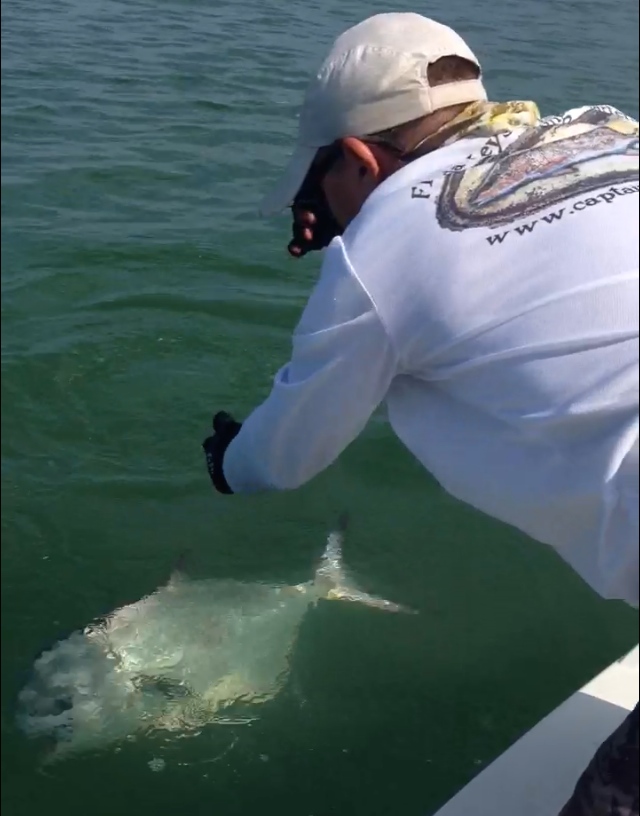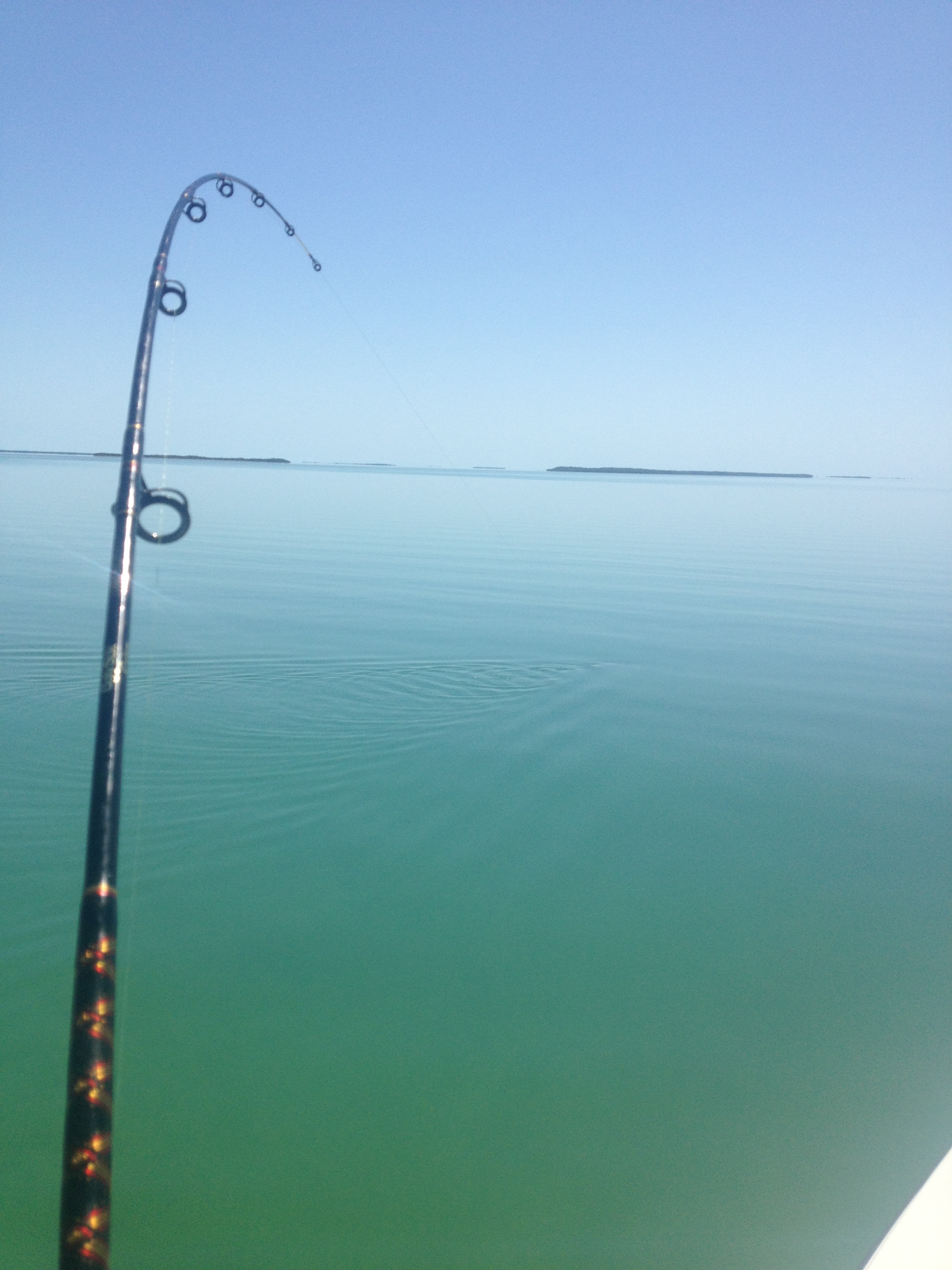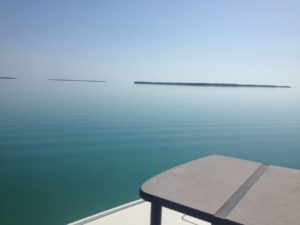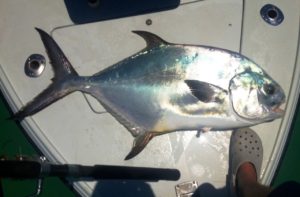April-May is my favorite time of the year in the Florida Keys. One of the many reasons has to do with what I feel is the most exciting species to pursue: Permit. Members of the jack family, permit (Trachinotus falcatusare) are one of the most sought after fish on the Florida Keys flats. While bonefish are known for their speed and tarpon for their acrobatics, permit are arguably the strongest, toughest fighter in the inshore waters of South Florida. They feed on crabs, shrimp and small fish and will come into shallow water to feed on them. It is super-exciting to come across them “tailing” in the shallows with their scythe-like fins popping up, flicking from side to side and then dropping back underwater.
Like bonefish, they are extremely wary animals. One false move or sound will send them bolting away before you can get a cast at them. Nothing gets my heart pumping more than the pursuit of these fish. Permit are primarily caught by sight fishing (seeing the fish and casting to it in hopes that it will eat your bait), so flat-calm days are always the best days to find them. On the other hand, fish are always more spooky on still water, so it makes it more challenging. One problem is that if you put your cast too close to it, it can spook. If you put your cast too far, it won’t see it and won’t bite. Like Goldilocks, you need to get it just right to get your permit bite.
In early April, I fished with a lot of clients and had very little free time. In mid-April, my best friend got married in Tuscany. By the time I returned from Italy in early May, I had the permit monkey on my back. I kept an eye on my Windfinder app on my iPhone and saw a flat-calm window coming mid-week. I had a charter booked for 1pm that day, but I knew I could get in a couple of hours of permit fishing and be back in time for the day’s trip. Live crabs are the preferred bait for permit. I like to use ones that are about 3” across. They are large enough to cast well, but not so big that they spook the fish when they hit the water. I had a few healthy ones in my pen, so I tossed them in the live-well of my boat, grabbed my dog Lola and headed to the permit grounds.
The bay was dead calm, gorgeous and otherworldly. On days like these, the glass-like water can be somewhat disorienting, as sky and horizon are indistinguishable and shallows and deep water look the same. I had rigged one of my favorite combinations for the day; an Uglystik Custom 12-15lb rod with a Shimano Sedona 4000 reel. It is spooled with 20lb Fireline braid. Attached to the end is six feet of 20lb fluorocarbon leader and a 2-0 circle hook.
I pulled up to a spot where I had seen them the month before, turned off the motor and started looking for signs of life. It was dead-quiet and the still water was surreal. The bay looked like a sheet of glass or layer of blue ice. As quietly as I could, I opened my bait well, picked out a crab and gently eased the circle hook through the corner of its shell. The crab I had chosen had pinched the heck out of me when I took it out of the pen earlier. I was hoping a big, hungry permit would give it some pay back for me. I laid my rod on the poling platform with the hooked crab dangling in the water, climbed up on it and began my search.
A lot of people who know and have fished with me say that I have good eyes. My vision isn’t better than anyone else’s, but I do know HOW to look for fish. The key is to “open your eyes”. That means instead of scanning the water intensely one area at a time, you broaden your vision so that your eyes become kind of a wide angle or “fish eye” lens. As you shift your broad gaze over different areas, any movements will catch your eye. When you do see movement; THAT is when you focus on a specific area. When water is totally flat, every fish moving near the surface stands out like a sore thumb. The key is to be able to distinguish a sport fish from one that is not sought after like a mullet. Big fish have wider backs than smaller, so the width of the wake makes a difference. The real art, however, is being able to differentiate between a ray, shark or permit by the shape and pattern of its wake.
It’s hard to tell exactly how long I stood on my platform after turning off the boat engine, but it couldn’t have been more than ten minutes when I saw movement. About a hundred yards away at about one o’clock from the bow, came the steady wake of a large fish. My heart skipped a beat and my breath caught in my throat as realized that I was seeing a large permit heading in my direction. It was coming at me on the diagonal from right to left. I reached down, spun the handle on my trolling motor and started to steer the boat in a direction that would put me directly in the path of the fish. After going about a hundred feet, I stopped the motor, climbed down, grabbed my rod and stepped gingerly to the casting platform on the bow.
The permit was slowly ambling along and cruising at a steady pace. So far it hadn’t seemed alerted by my presence, but that could change any second. My heart was racing as I flipped open the bail on my reel, cocked back and pitched the crab to the fish. Time stood still as the crustacean arched through the air and landed within a foot of its wake. At first it seemed that the permit had not seen the bait. It continued on its steady path through the water and past the crab. Suddenly, it flicked its tail and with a huge boil and pulled a massive u-turn towards the flailing crab. Water splashed and boiled as it chomped the bait and took off like a freight train.
My heart was in my throat as the fish ripped line off my spool at an alarming rate. Within a few seconds the fish had taken over a hundred yards. I knew I was in for a battle. I took a short video on my iPhone. It was then that I realized that my hands were shaking from the adrenaline. This was a fish of a lifetime. I stepped down from the casting platform, keeping the rod bent as I moved, and eased back to where my trolling motor is mounted. I turned the handle on the motor to “5” and started after it.
The initial runs of the fish were hard, intense and somewhat intimidating. Just when I thought it was done; it would kick its massive forked tail and shoot out ahead, taking fifty yards of line or more. We got into a pattern. I’d follow with the trolling motor and reel up as much line as I could. Then the fish would explode in a strong burst and strip out all of the line I had gained back out. I followed and reeled and it stripped it out again. This went on and on as the minutes ticked on and the motor pushed us along after the fish.
Permit are solid muscle and they fight like the devil, but their shape is an asset to them as well. When they are hooked and fighting, they will turn on their side and lean against you. Picture trying to pull a manhole cover sideways through the water and you’ll get the idea. I had been taking the occasional picture and video of the fight on my iPhone when it rang in my hand. It was my good friend Brian who is also an avid permit fisherman. I told him about the fish and he was very stoked for me. He wished me luck and let me get back to the fight. It was then that I realized I had been battling this fish for over an hour. At this point I was starting to get tired. My arm and shoulder were throbbing, my right hand and fingers were cramping and I was covered in sweat from the exertion and dead-calm, sunny day.
By now, I had the permit hovering about 50 feet from the boat. I turned off the trolling motor and began letting it tow the boat in an effort to tire it out. Its runs had gotten shorter, but the steady kick of that massive forked tail was pumping like well-oiled machinery. It was such an amazing sight to see such a beautiful creature, with so much power, in the crystal-clear water. The closer I got to the fish, the bigger I realized it was. As it slowly circled the boat, I began to put more and more heat (pressure) on the rod.
I finally had it in range where I could start thinking about trying to land it. I opened my bow hatch and pulled out my collapsible net. I immediately realized that I was under-netted. At this point, I had put an hour and a half into the fight when another good friend and avid permit fisherman, Matt, called. My voice was shaky as I told him about the beast on the end of my line. He was excited for me, but concerned as I told him about my landing net predicament. He said, “Dave you’re going to just have to man-up and grab that puppy by the fork of the tail.” With those encouraging words, he let me get back to my ordeal. I stood on the bow, lifted the rod high, cupped the spool and stepped back as I reeled down on the fish. After it made several circles, I saw my shot coming.
Grabbing the base of the forked tail is a good way to land most permit and jacks, but I could see that this one was about 5 inches wide. I was concerned about getting a good grip on it. The concern was well founded. As the behemoth turned on its side, I shot my hand out and grabbed it. I got a grip on the base of the tail, but my hand and fingers were cramped and weak from almost two hours of abuse. I had it halfway out of the water when it thrashed its massive tail and shot back into the water. The fish pulled out more line and went back to circling the boat.
At this point, I had had enough. I altered my plan. After gaining back the line I’d lost, I wound down on the reel, cupped the spool and stepped back. When it turned sideways again, I jammed the rod into the bow rod holder, bent down and grabbed the fork of the tail with both hands. I squeezed with everything I had and held on as it thrashed and struggled. With a tight grip, I fell backward into the boat with the fish on top of me. I had boated the permit and I was euphoric! I quickly removed the hook, measured its length and took photos and video. It was enormous! It was 40 inches long and over 35 pounds.
Normally, my dog Lola jumps all over a boated fish, but she stayed in her place on the back seat this time. I think she may have been a bit intimidated by its massive size. I picked up the bruiser and eased him over the side. I began to revive it by sliding it back and forth in the water. It kicked its tail rhythmically almost immediately, which is always a good sign. After a less than a minute, it was ready to be released. With great respect, awe and relief, I let go of the animal. It swam away healthy to fight another day. I stowed my rod, grabbed a bottle of water, started the boat and headed home.






